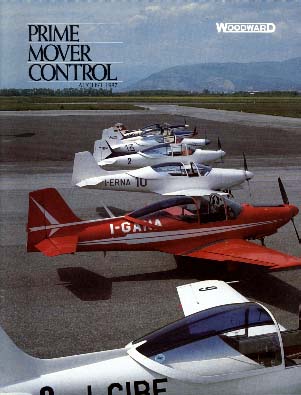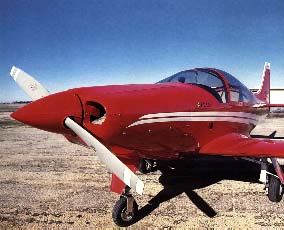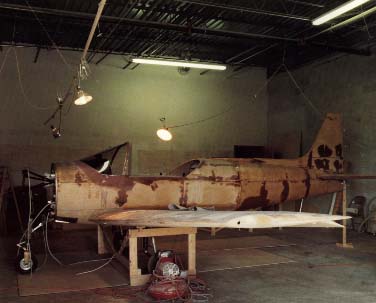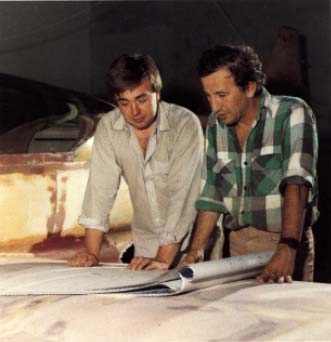F.8L Falco:
The Hawk That Sequoia
Rebuilt
![]()
F.8L Falco:
|
|
|
This article appeared in the August 1987 issue of Prime Mover Control, a publication of Woodward Governor Company for their employees and distributors. |

It all begins with the desire to build and recreate a classic flying machine; to construct the same plane that the famous aeronautical engineer, Stelio Frati designed thirty-three years ago.
Thanks to the Sequoia Aircraft Corporation, Richmond, Virginia, there is a kit version of the F.8L Falco available for homebuilders. Alfred Scott, president of the Sequoia Aircraft Corporation, painstakingly revised the original plans after acquiring the rights to them in 1977. Revisions and modifications in the plans were made to simplify the construction and to increase performance, utility, and comfort. Sequoia has since been developing and distributing the twenty-three complete and different kits it takes to build a Sequoia Falco.

Throughout the modifications, the basic airframe design has remained the same, so the Sequoia Falco looks as sleek as the production F.8L Falco that first flew in 1955. Inside the cockpit, the instrument panel was completely redesigned. Controls, instruments, and switches were rearranged more logically and up to modern standards, providing more room for full IFR avionics and instruments.
Increasing the fuel capacity to forty gallons enhanced the performance and utility of the Falco. It now has a range in excess of 1,000 miles. There is also a small, two-gallon header tank that allows for a reasonable amount of inverted time, making the Falco an aerobatic plane as well as a cross-country plane.
Dr. Pawel Kwiecinski has lived and practiced medicine in Chicago, Illinois, U.S.A. for six years. In a rented industrial building, and in less than one year, he built himself a Falco. Champion acrobatic pilot, Irek Mikolajczyk worked full time on the airplane from September 1986 to July 1987. Dr. Kwiecinski devoted about three hours a day and most of his weekends to help finish his Falco in time for the 1987 OshLosh EAA Fly-in. All told, about 3,000 hours of labor were put into the construction of the plane.
To build a Falco, you begin with the tail section. It is described as the builder's initiation to the rest of the airplane construction. About ninety percent of the work required to build the plane is wood work. This, very basically, involves glueing, drilling, and sanding. All of the wooden parts for the Falco are supplied by Trimcraft Aero, Burlington, Wisconsin, U.S.A. Other parts are obtainable through the Sequoia Aircraft Corporation.

Dr. Kwiecinski's plane took two builders and about 3000 hours
to complete.
After the tail section is complete, you move on to the wings and fuselage assembly. A number of fittings are installed along the way, and then the plane is skinned. The basic structure of the Falco is built entirely of aircraft grade Sitka spruce and aircraft grade birch plywood. For Dr. Kwiecinski, the most difficult and time consuming parts of the construction were the flaps, ailerons, and canopy. The engine, cowling, baffling, and avionics are installed after the body is complete.
Recommended engines include the 180-hp Lycoming 10-360-B I E, which permits greater speeds with good takeoff and cl imb performance (although with slightly higher fuel consumption). The Lycoming 160-hp IO320-BIA (the engine chosen by Dr. Kwiecinski) or 150-hp 10-320-AIA can also be used. All are recommended in conjuction with a Hartzell constant speed propeller, a Hartzell spinner, and Woodward Governor Company's B210345 constant speed propeller governor.
There are seven Sequoia paint schemes, each named after a town in Italy. Dr. Kwiecinski chose to paint his plane in a red-with-white scheme called "San Marino."
Dr. Kwiecinski is a seasoned pilot. He owns a 1983 Piper Dakota which he flies an average of 200 hours a year. The Falco's "beautiful lines, good performance, and aerobatic capabilities" convinced him to build it for his second plane.

Dr. Pawel Kwiecinski (left) built his F.8L Falco in less than
a year
with the help of champion acrobatic pilot Irek Mikolajczyk (right).
According to Dr. Kwiecinski, "There is nothing better than Frati's design." He compares it and any other plane -- production or kit -- to the difference between a taxicab and a Porsche. Those other planes will get you from point A to point B, but for the pure pleasure of flying -- aerobatic or cross-country -- the Falco is the plane to fly.
Thus, the Falco has been described as a pilot's airplane. Its greatest characteristics are its sensitive, responsive controls that are equally balanced for agile maneuvering. All Falcos built from Sequoia plans and kits are performance planes. They fly at greater speeds than the factory built aircraft. Several are capable of cruise speeds of over 210 mph.
The Sequoia Falco is an all-wood retractable aircraft with side-by-side seating for two. It gives you the freedom and the ability to fly in high speed travel or in jet-like aerobatics. But, perhaps its greatest feature is the bond you have with a plane you build yourself.
|
|